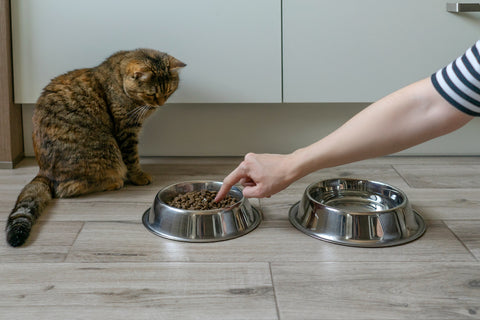Decoding Cat Appetite: Why is My Cat Not Eating?
A cat not eating can be concerning for any pet owner. There are several reasons why your cat might be avoiding food, ranging from minor issues to more serious health concerns.
Why Your Cat Isn't Eating and What It Might Signify
Common Reasons Why Cats Stop Eating
Cats may stop eating for various reasons, and it's crucial to monitor their behavior closely as a sudden change in appetite can indicate an underlying issue. Some common reasons include:
Health Problems: Cats can develop various health issues that affect their appetite, such as dental problems, gastrointestinal troubles, infections, kidney disease, or urinary tract issues.
Stress or Anxiety: Changes in their environment, such as moving to a new house, a new pet, or changes in their routine, can stress cats and lead to a loss of appetite.
Dietary Changes: Cats can be picky eaters. If their food brand or type changes suddenly, they might refuse to eat until they get used to the new diet.
Behavioral Issues: Some behavioral problems or anxiety can manifest in loss of appetite. This might occur if a cat is bullied by other pets or feels threatened during mealtime.

Medication Side Effects: Certain medications can affect a cat's appetite. If your cat has started a new medication and their appetite changes, consult your vet.
Dental Problems: Tooth decay, gum disease, or other dental issues can make eating painful for cats, leading to a decreased appetite.
Age-related Changes: Older cats may have reduced appetites due to age-related issues or declining senses, like reduced smell or taste.
Toxin Ingestion or Poisoning: Cats are curious animals and might ingest something toxic, leading to loss of appetite among other symptoms.
Environmental Changes: Extreme temperatures or environmental factors can sometimes affect a cat's appetite.
If your cat stops eating or shows a prolonged decrease in appetite, it's crucial to consult a veterinarian promptly. Sudden changes in eating habits can be an indication of a serious health problem that needs immediate attention.
What You Can Do If Your Cat Not Eating?
If your cat is not eating, here are some steps you can take:
Monitor Closely: Keep an eye on your cat's behavior, energy levels, and any other symptoms. Note how long they've gone without eating.
Check for Obvious Issues: Look for signs of dental problems, injuries, or anything unusual in their mouth or behavior.
Offer Tempting Foods: Try offering different types of food, such as wet food, cooked chicken or fish (without seasoning), or cat treats. Sometimes a change in diet or something more appetizing might entice them to eat.
Warm the Food: Warming up their food slightly can enhance its aroma and make it more appealing to your cat.
Ensure a Stress-free Environment: Cats can stop eating due to stress. Ensure they have a calm and comfortable environment without disruptions. Provide hiding spots if they feel anxious.
Encourage Hydration: Ensure your cat is drinking water. Sometimes, offering wet food or adding water to their dry food can help keep them hydrated.
Consult a Veterinarian: If your cat refuses to eat for more than 24 hours, it's essential to consult a vet. Loss of appetite can be a sign of an underlying health issue, and professional evaluation is crucial.
Follow Vet Recommendations: Once you've consulted with the vet, follow their advice diligently. They might recommend specific treatments, medications, or a change in diet to address the underlying cause.
Remember, a cat not eating can be a serious concern, especially if it lasts for more than a day.
Implementing Effective Feeding Strategies to Encourage Your Cat to Eat
Encouraging a cat to eat can be challenging at times, especially if they're picky or have health issues affecting their appetite. Here are some effective feeding strategies:
Create a Feeding Routine:
Consistency: Feed your cat at the same times every day to establish a routine.
Limited Time: Offer food for about 20-30 minutes. If they don't eat, remove the food until the next mealtime to prevent spoilage and encourage hunger.
Food Choices:
Variety: Offer a variety of textures (wet, dry, semi-moist) and flavors to find what your cat prefers.
High-Quality Food: Opt for high-quality cat food, considering your cat's age, health, and dietary needs. Consult your vet for recommendations.
Feeding Environment:
Quiet and Calm: Choose a peaceful feeding spot away from noise and disruptions.
Separate Spaces: If you have multiple cats, provide separate feeding stations to prevent competition and stress during mealtime.
Food Presentation:
Freshness: Ensure the food is fresh, especially for wet food. Warm it slightly to enhance aroma and make it more appealing.
Food Puzzles or Interactive Feeders: Use toys or puzzles that dispense food to stimulate your cat's interest in eating.

Feeding Techniques:
Hand Feeding: Offer small amounts of food by hand to entice your cat to eat. Some cats respond well to this personal interaction.
Gradual Transition: If changing diets, mix a bit of the new food with the old and gradually increase the new food portion over a week or so.
Avoid Force Feeding:
Forcing a cat to eat may create stress and aversion to food. It's better to encourage and entice rather than force.
Appetite Stimulants:
Your vet might recommend appetite stimulants or supplements if your cat has a reduced appetite due to illness.
Remember, every cat is unique, so patience and experimentation are key.
Leave a comment
